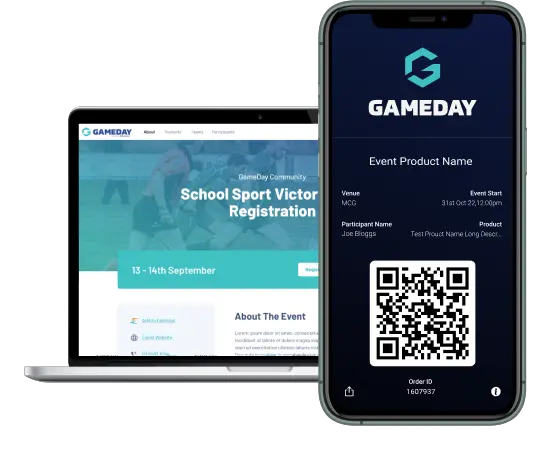Backyard Fundamentals
PLAYERS "POSITION" AND "MOVEMENT"
It is very important that you teach your children the importance of proper footwork.
The "Ready" Position
The most basic basketball position is the ready position. Instruct your child to stand relaxed with arms and legs bent, feet shoulder width apart, and weight shifted slightly forward to the balls of the feet. From this position a player can run forward of backward, slide to side, cut, pivot, or jump!
Stopping
One of the most common errors beginners make is "traveling", usually due to poor stopping skills. Once you have explained the ready position to your youngster, you will want to help them learn how to stop and start with their bodies under control. Beginners need to learn the jump stop so they can stop after moving quickly either with or without the basketball.
Jump Stop
Have your youngster begin in the ready position, then blow a whistle and have them sprint forward five or six steps. When they hear your whistle a second time, have them stop quickly with both feet simultaneously hitting the floor, landing in a balanced, ready position. By using the jump stop, players are able to gather and control their forward momentum and may use either foot as a pivot foot.
Pivots, Cuts and Slides
After your youngster has mastered the jump stop, you will want to help them with some other basic footwork: turning or pivoting on either foot to change direction pushing off either foot when running to cut quickly sliding their feet on defense without crossing them.
Pivots
Along with helping your youngster to master the ready position and the jump stop, helping them to pivot correctly will give them a lot of confidence in their footwork. A pivot simply involves stopping, then turning on one foot to move forward (front pivot) or dropping one foot backward (back pivot) all while keeping the ball of one foot on the court
Remind your youngster that after they have used a jump stop they may choose either foot as their pivot foot, but they may not change that pivot foot, while in possession of the ball.
Each time they receive the ball they should assume the ready position, and then they may use their pivot foot to
pivot to protect the ball from the defense
pivot to pass to a teammate, or
pivot to make a move to the basket.
Cuts
The ability to change direction quickly and in balance is important at both ends of the court. Offensive players will have trouble getting open for passes or shots if they can not "lose" their opponents with quick cuts while defenders will find it difficult to keep up with offensive players if they are unable to respond to various cuts.
Therefore, teach your youngster how to cut on the court by having them practice planting one foot on the court at the end of a stride, then pushing off that foot to shift their momentum in another direction. For example, tell them to push off with the left foot if they wish to cut to the right. Then they should turn the unplanted foot in the direction in which they want to go and lead with that leg as they burst towards the new direction. When cutting, players should learn to bend their knees to lower their center of gravity and provide explosiveness to their legs. Effective cuts are hard, sharp, and explosive.
Slides
Defenders must be able to slide their feet and maintain an arm's distance from their opponent who is attempting to drive or cut to the basket. Youngsters are usually more comfortable with forward than lateral movement and tend to cross their feet when attempting to move sideways. Instruct your youngster to stand in the ready position and then move the leg nearest their intended direction about 60cm to that side. Next they should slide the other foot until the feet once again are shoulder width apart
Remind them to keep their toes pointed forward and to move as quickly as possible on the balls of their feet. They will be able to slide more quickly if they keep their knees bent, rear down, and backs erect.
Error Detection and Correction for Pivoting
Youngsters are often unsure of how to move or run without using the dribble when they have the basketball. Therefore, they need help in learning how to pivot with the ball.
ERROR
Moving and switching the pivot foot while in position of the basketball.
CORRECTION
1. Teach your youngster to use the jump stop so that they can use either foot to pivot on
2. Teach your youngster to pivot away from the defensive pressure (opposing player) and square up to face the basket as soon as they receive the basketball.
3. Remind your youngster that once they choose a pivot foot, they can not lift that foot from or slide it across the floor.
4. Encourage them to take full advantage of their ability to pivot in either direction as long as they keep the ball of the pivot foot in the same spot.
A PLAYER "BALLHANDLING SKILLS"
A key to success in basketball is moving the basketball effectively into position to take high percentage shots. Therefore the skills of passing, catching. dribbling. and shooting are essential to success in basketball.
Passing
Passing is an offensive (attacking) skill used to maintain possession and create scoring opportunities. Passes should usually be short and crisp, because long or slow passes are likely to be stolen by an opposing player. However, players should avoid throwing too hard or using passes that are difficult to control. Players should pass the ball above the waist and within easy reach of the intended receiver. If possible, passes should be thrown to the intended receiver's side that is farthest from her or his defender. As your youngster becomes more skilled, work with them on faking a pass one way, then passing another. Keep it simple by starting off with these four types of passes.
Chest Pass.
An often-overlooked element of good passing is how to use the legs to generate the momentum for a pass. Begin by teaching your youngster to start in the ready position and always to step towards their target to initiate the pass. The Chest Pass is so named because the ball is thrown with two hands from the passer's chest to the Intended receiver's chest area. Teach your youngster to throw the pass with their thumbs snapping down and together.
Bounce Pass
.Sometimes it is easier for a passer to get the ball to a teammate by bouncing the basketball once on the court before it reaches the intended receiver.
For example, a defender may be guarding a player with both hands overhead, preventing a pass through the air to a teammate. In that case a bounce pass may be the only route to get the ball to a teammate. Instruct your youngster to use bounce passes when they are closely guarded and may not have the space to extend their arms in a chest pass.
Teach your youngster to bounce the ball on the court two-thirds of the way between themselves and their intended receiver.
Remind them to use their legs and step towards the target. Snapping their thumbs down and together as they release the pass will give the ball some backspin. Backspin will slow the pass down a little as it hits the floor and give the intended receiver a chance to catch the ball at waist level in ready position.
Two-Hand Overhead Pass
Another pass option is the two-hand overhead pass. This pass is often a good way for a guard to get the ball to a center or forward in the keyway. It is also useful for throwing an outlet pass to a teammate on a fast break.
The pass must be thrown with a hand on each side of the basketball, with the thumbs behind the ball. The ball should not be brought too far behind the head, or it will become vulnerable to the defense. The passer must generate momentum towards the target by stepping first with the legs and following through with both arms extended. Tell your youngster to aim for the intended receiver's head, because that's where the receiver wants to catch the ball, just above the head.
One-Hand Bounce Pass
This is a good pass for beginners to learn as they try to combine their pivoting and passing skills. A player who is closely guarded may not have the room to fully extend and make a crisp chest, bounce, or overhead pass. Thus the one-hand bounce pass is quick, short, crisp pass used to get the ball to a cutting teammate. Beginners and advanced players alike may use this pass effectively to pass around defenders.
Catching
Even the best passes are of little value if they are not caught. Sloppy receiving technique is often the cause for turnovers and missed scoring opportunities. Emphasize the following receiving techniques:
![]() Show a target to the passer and call for the ball
Show a target to the passer and call for the ball
![]() Move to meet the pass, step toward the ball - not away
Move to meet the pass, step toward the ball - not away
![]() Watch the ball into the hands
Watch the ball into the hands
![]() Use two hands, palms facing the passer, thumbs together
Use two hands, palms facing the passer, thumbs together
In most situations after receiving a pass, players should come to a jump stop with their feet positioned shoulder-width apart ready position.
DRIBBLING
If there is one thing that young players like to do when they get their hands on a basketball, it's to bounce it. Unfortunately, when they practice on their own, only a few players dribble correctly or use techniques that will improve their dribbling skill. Therefore YOU will have to teach your youngster how to dribble effectively and watch that they use the correct dribbling technique as shown in illustration. Teaching correct dribbling technique is problematic, because most of them have already established incorrect dribbling habits. The three most common errors of self taught youngsters are these; Slapping at the ball from the chest area and waiting for it to bounce back up;
Keeping the head down, with eyes riveted to each bounce; And using one hand exclusively to bounce the ball.
As YOU correct these dribbling errors and attempt to improve your youngsters dribbling skills, advise them to
![]() establish a feel for the ball, with the pads of the fingers;
establish a feel for the ball, with the pads of the fingers;
![]() maintain the ready position, keeping knees bent and rear down;
maintain the ready position, keeping knees bent and rear down;
![]() keep the dribble under control and always bounce the ball below waist height, and even closer to the floor when being guarded closely;
keep the dribble under control and always bounce the ball below waist height, and even closer to the floor when being guarded closely;
![]() bounce the ball close to the body and protect the dribble from the defender with the non-dribbling hand and arm;
bounce the ball close to the body and protect the dribble from the defender with the non-dribbling hand and arm;
![]() keep the head up and see the rest of the court (and teammates!) learn how to dribble with the right and left hands; and
keep the head up and see the rest of the court (and teammates!) learn how to dribble with the right and left hands; and
![]() keep practicing
keep practicing
DRIBBLING Dos and Don'ts
DO.....
![]() keep the dribble "alive" until you have a shot or an open teammate to pass to
keep the dribble "alive" until you have a shot or an open teammate to pass to
![]() vary the speed and direction of the dribble so defenders are kept off guard
vary the speed and direction of the dribble so defenders are kept off guard
![]() protect the dribble from the defensive player with the non-dribbling arm when being closely guarded
protect the dribble from the defensive player with the non-dribbling arm when being closely guarded
![]() Crossover or switch dribbling hands to protect the ball after dribbling past the defender
Crossover or switch dribbling hands to protect the ball after dribbling past the defender
![]() Stay in the middle of the court and away from the sidelines and corners to avoid being trapped.
Stay in the middle of the court and away from the sidelines and corners to avoid being trapped.
DON'T
![]() automatically start dribbling after receiving a pass. Look to see what shooting or passing options are available after squaring up to the basket
automatically start dribbling after receiving a pass. Look to see what shooting or passing options are available after squaring up to the basket
![]() Pick up or stop dribbling with no other option (i.e. shoot or pass) available
Pick up or stop dribbling with no other option (i.e. shoot or pass) available
![]() Dribble into a crowd - the ball is more likely to be stolen
Dribble into a crowd - the ball is more likely to be stolen
![]() Try to get fancy when good fundamental dribbling will do the job
Try to get fancy when good fundamental dribbling will do the job
![]() Hesitate. Be assertive and confident when dribbling the ball
Hesitate. Be assertive and confident when dribbling the ball
A PLAYER’S "SHOOTING SKILLS"
Every player loves to put the basketball through the hoop. So your youngster will be highly motivated, to learn proper shooting technique, if you convince them that it will help, make them make more of their shots. To get the fundamentals of shooting across and encourage your youngster to learn them, tell them that they will SCORE if they do these things:
S- Select only high percentage shots.
C- Concentrate on their target.
O - Order movements: square up, bend knees and elbows, cock wrist.
R- Release and wave "good-bye" to the ball.
E- Extend the shooting arm up and toward the basket.
Players can shoot the ball in a variety of ways, including jump shots, set shots, free throws, and lay-ups. Introduce your youngster to each variation, and emphasize the shots that they are most capable of executing at their stage of development.
Jump and Set Shots
Although the most common shot at higher levels of play is the jump shot, young players who lack the leg strength and co-ordination to spring from the floor while shooting will more often shoot set shots. So teach your youngster the mechanics of the set shot first, and they will be able to advance to the jump shot as they increase strength and improve co-ordination. Teach your youngster these shooting mechanics in this sequence:
![]() Lay the ball on the finger pads of each hand, with the shooting hand behind and slightly underneath the ball and the non-shooting hand balancing the ball from the side.
Lay the ball on the finger pads of each hand, with the shooting hand behind and slightly underneath the ball and the non-shooting hand balancing the ball from the side.
![]() Focus on a specific target, usually the rim or backboard. The middle of the rim should be the target for most shots, but when at a 30- to 60- degree angle from the hoop, sight the comer of the square on the backboard for a bank shot.
Focus on a specific target, usually the rim or backboard. The middle of the rim should be the target for most shots, but when at a 30- to 60- degree angle from the hoop, sight the comer of the square on the backboard for a bank shot.
![]() Align shoulders, hips, and feet square with (facing) the basket. The foot of the shooting hand side can be up to 15cm in front of the other foot so that the base of support is comfortable and balanced.
Align shoulders, hips, and feet square with (facing) the basket. The foot of the shooting hand side can be up to 15cm in front of the other foot so that the base of support is comfortable and balanced.
![]() Bend the knees to get momentum for the shot. Let the legs, not the arms, be the primary power source for the shot.
Bend the knees to get momentum for the shot. Let the legs, not the arms, be the primary power source for the shot.
![]() Bend the shooting arm elbow to approximately a 90-degree angle, keeping the forearm perpendicular to the floor and in front of the cocked wrist as the ball is brought up to the shooting position above the forehead.
Bend the shooting arm elbow to approximately a 90-degree angle, keeping the forearm perpendicular to the floor and in front of the cocked wrist as the ball is brought up to the shooting position above the forehead.
Sighting the basket Stance Follow through
![]() As the legs are extended, release the ball by extending the elbow, bringing the wrist forward, and moving the fingers of the shooting hand up and through the ball. The non-shooting arm and hand should maintain their supportive position on the side of the ball until after release.
As the legs are extended, release the ball by extending the elbow, bringing the wrist forward, and moving the fingers of the shooting hand up and through the ball. The non-shooting arm and hand should maintain their supportive position on the side of the ball until after release.
![]() Follow through after the release by landing on both feet, extending the shooting arm and dropping the wrist, pointing the index finger of the shooting hand directly at the basket. .
Follow through after the release by landing on both feet, extending the shooting arm and dropping the wrist, pointing the index finger of the shooting hand directly at the basket. .
For some time your youngster will probably have difficulty in shooting the ball properly. That is because they have developed bad shooting habits, and the correct shooting motion is awkward for them. Check that our youngster is not shooting "line drives"
Error Detection and Correction for Shooting
Many youngsters take a dribble before every shot. This is a bad habit because it allows the defense to recover and prevent, pressure, or block the shot. So, you will want to break them of this habit and get them to shoot without putting the ball on the floor.
ERROR
Automatically dribbling before shooting when open, within good shooting range, or without a clear path to the basket.
CORRECTION
![]() Receive the pass and pivot to face the basket in the ready position
Receive the pass and pivot to face the basket in the ready position
![]() Hold the ball in preparation for a shot or a two handed pass.
Hold the ball in preparation for a shot or a two handed pass.
![]() Check where the defense is positioned, whether a shot is open and whether a teammate closer to the basket is open.
Check where the defense is positioned, whether a shot is open and whether a teammate closer to the basket is open.
![]() If the nearest defender does not deny the shot and no teammate is open for a higher percentage shot, shoot the ball.
If the nearest defender does not deny the shot and no teammate is open for a higher percentage shot, shoot the ball.
![]() Check possible options before shooting.
Check possible options before shooting.
Free Throws
After shooting fouls, and when the team is in the bonus, the player fouled is awarded free throws.
The free throw is nothing more than an uncontested set shot from a designated spot - the free throw line.
Players should use the same shooting mechanics outlines for the jump and set shots.
However, because free throw attempts are unhurried and uncontested, teach youngsters to take a deep breath and take their time before shooting. Encourage them to think positive thoughts (i.e. "This one is " IN") or visualize their shot falling through the net. These positive affirmations, along with proper form, will help your youngster take advantage of their trips to the line.
Lay-Ups
The highest percentage shot, and therefore the most desirable shot, is a lay-up. However, with young and inexperienced players, lay-ups are hardly "gimmies", so YOU will need to work with your youngster on proper lay-up technique from both sides of the basket.
A lay-up is a one-handed shot taken within 1/2 metre of the basket. Teach them to use their left hands when shooting lay-ups from the left hand side of the basket and their right hand from the right side of the basket.
The lay-up motion begins with the player planting and exploding (much like a high jumper) off the foot opposite the shooting hand, after striding from a 45-degree angle to the hoop.
The player explodes off the planted foot straight up into the air. At the top of the jump, the player releases the ball by bringing the shooting hand, which is underneath the ball and near the shoulder, up towards the basket
As in the jump and set shots, the index finger of the shooting hand should be pointed directly at the basket or the appropriate spot on the backboard. Teach beginning youngsters always to use the backboard on their lay-ups. It gives them a steady target to aim for every time.
Your right handed youngster is likely to find left-handed lay-ups troublesome, just as your left handed youngster is going to find right-handed lay-ups difficult. Point out to them the reason for using the hand farthest from the basket to shoot the ball: The ball is more easily protected and less easily blocked.
Then "walk" them through the proper footwork taking one step with their left foot and exploding up to shoot with no dribble on the right side. Then have them back up a step with their right, then left and shoot. Get the players saying out loud, right, left, backboard. Finally have them back up and dribble once, stepping right, then left and shooting.
Repeat this walk through (no dribble) sequence on the left side. Once they get the mechanics down without worrying about dribbling, they can speed up their approach and add the drive.











Comments
Comment Guidelines: The SportsTG Network is made up of players, families and passionate sports followers like you who have a strong opinion about sport. That's great - we want you to have your say and share your thoughts with the world. However, we have a few rules that you must follow to keep it fun for all. Please don't be rude, abusive, swear or vilify others. Apart from some pretty serious sport sanctions, we also can ban you and report you if things get out of hand. So play fair and have fun, and thanks for your contribution.